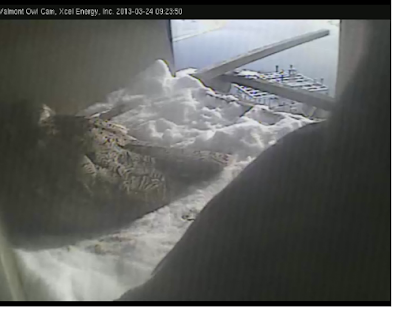We are sometimes asked why we band birds. Banding birds provides an invaluable way to study their life histories and chart changes in bird populations, including changes in range, population numbers, and migratory behaviors. Bands do not hurt birds or impact their individual or reproductive success.
There are a number of different ways to band or mark birds. We use two leg bands on Peregrines: an aluminum leg band (currently silver in the midwest) on the right leg, and a multi-color band (currently black/red in the midwest) on the left leg. Both bands are very light and fitted after the bird's leg is fully or very near adult size. The silver band contains a long number with a unique federal identifer assigned by the North American bird banding lab. The multi-colored band is an auxillary marker distributed regionally by the Raptor Center at the University of Minnesota. The numbers are larger and etched in a different color than the band, so they are easier to read.
In general, we band young peregrines taken from the nest by hand between 20-30 days of age, before they start flying. Banding can take anywhere from 15 minutes to an hour, depending on the site. Once we return the young falcons to the nest, their parents come back quickly - we have never witnessed a peregrine abandon young after banding. We used a pan dam trap to catch bald eagles D1 and D14 after they were on the wing. Other methods of trapping flying birds include mist nets, rocket nets, bal-chatri traps, or even hand catch depending on the size, weight, and wariness or aggressiveness of the bird in question.
 |
Banding tools. Band colors may differ from year to year and
region to region. |
One of the team usually holds the bird while someone else bands it. Both bands are fitted around the bird's legs before they are closed. The aluminum band is closed with a pliers and the multi-color band with a pop-rivet gun: a technique developed by Charles (Chuck) Sindelar, who still bands with us and was instrumental in bald eagle recovery in Wisconsin. Since female birds of prey are larger than male birds of prey, females take slightly bigger bands. We sex peregrines by tarsus thickness and 'voice' (female birds have lower voices). Although male bands are smaller than female bands, we discovered that females banded as males aren't damaged when we trapped 'Husker', a 1998 fledge from the Woodman Tower in Nebraska. Husker, a female banded as a male, fledged 19 young between 2001 and 2007. Her slightly tighter bands didn't affect her legs or her ability to care and provide for her young.
When we band peregrines, we record the federal band number, the auxiliary band number, the bird's gender, the actual or approximate age of the bird, the site name, the site coordinates, the bird bander, and other notes (parent bands, overall bird health, any treatments given (such as Spartrix for Frounce), and so on). We report this information to the Bird Banding Lab (BBL) and the Midwest Peregrine Falcon Database, an online interactive database maintained by the Midwest Peregrine Project and the Raptor Center.
Banding birds provides an invaluable source of information, since the bird's life history can be looked up and shared with others. Our peregrines have been spotted on oil rigs in the Gulf of Mexico, in the Eastern United States (traveling cross-country from the midwest), in Nebraska (traveling cross-country from Rochester, New York), in Florida, in Canada, and in many locations in Minnesota, Iowa, and Wisconsin. You can report bands to the Bird Banding Lab by calling 1-800-327-2263 or going to their website at
http://www.pwrc.usgs.gov/BBL/bblretrv/. If you have retrieved bands from a dead bird, you may keep them. You will need to know:
- What kind of band you are reporting. For a guide to bands, follow the link below...
- http://www.pwrc.usgs.gov/BBL/homepage/bandmarkerexample.cfm
- How you obtained the band
- The date you saw the band
- Band or marker info. There is a pretty good guide to markers on the site. There are three possible leg positions for leg-banded birds. Pick the one you think is closest to what you saw. You won't get in trouble for flubbing the position. You'll also be asked for band colors and code
- The location of the banded bird
If the Bird Banding Lab has information on the bird, you'll be emailed a cool certificate that provides information about your bird. The bird bander will also be notified. We love notifications!
 |
| My first certificate of appreciation |
We've banded Peregrines on power plant catwalks and in elevators, on rooftops, on the ground, and hanging from ropes. We've banded on calm sunny days and in howling near-gale force winds, racing down smokestacks and up cliffs just ahead of thunderstorms. Most thrillingly, we have witnessed 'banding season' go from one afternoon, when the Peregrine falcon was so highly endangered that only a handful were nesting in the midwest, to a month-long mad scramble to fit everyone in. Thanks to the efforts of bird banders, the return of the Peregrine falcon in the United States is perhaps the most documented population phenomena in natural history. We know the lineage, natal nests, life histories, and genetic make-up of the majority of Peregrines nesting in the United States today.
Watch this video for a look at Peregrine banding at Great Spirit Bluff near Dresbach, Minnesota.




